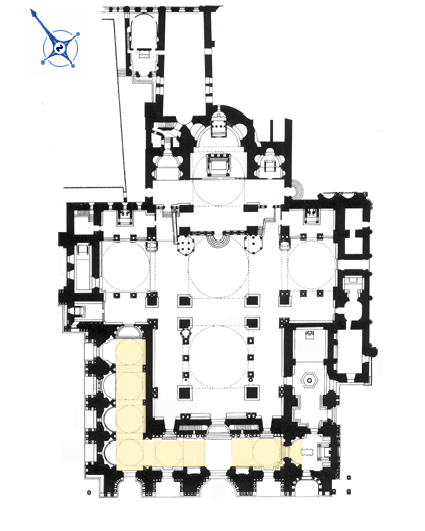 ATRIUM
ATRIUM
Passage from the square to the church is by way of the atrium, a place which, illuminated by the shining gold of its mosaics, pre-announces to the visitor the sacredness of the interior space.
The atrium was decorated during the 13th century with the mosaics of the cupolas, vaults and lunettes, the mature expression of a wholly Venetian workshop of mosaicists, and they bear witness to stylistic evolution over the almost sixty years it took to complete the work (1215-1280 approximately). The iconographic programme of this mosaic cycle is western in its handling of the biblical theme of the Old Testament though the formal model is the Cotton Bible, an early Christian illuminated text from the Alexandria area. The richness of the atrium mosaics lies chiefly in the spiritual message assigned them. These mosaics “mark” the time of awaiting Jesus’ advent, following the thread that identifies the phases of the history of salvation, after the fall of man and before its achievement in Christ whose life and mysteries are celebrated in the interior mosaics.
A broad narration of the great events of the Old Testament, selected from the books of Genesis and Exodus, begins from the south-west corner on the right and is developed along the west and north sides
CUPOLA OF THE CREATION
The first is the cupola of the Creation, set in three concentric circular strips around a central gold flake decoration. The story is divided into twenty-six scenes with biblical text in Latin above them. The first words are: “In the beginning God created heaven and earth. The Spirit of God moved on the face of the waters“. There follow the days of the Creation. Each one features the figure of God the creator, identified in accordance with oriental iconography as the young Christ with crossed halo and processional cross on a rod. The Living Word of the Father and with Him since the beginning of time creator of the universe, as we read at the beginning of the Gospel of St. John. The six days of the Creation are recounted in the scenes of the two more internal strips: the first day on which God separated light and darkness; the second on which he separated the waters from the emerged land, gathering the upper waters in heaven and the lower between the lands; the third on which he made all species of plants to grow upon the earth; the fourth on which he put sun and moon in the sky to light day and night; the fifth on which he populated the sea with fish, the sky with birds and created the animals of the land, here shown in pairs: first lions, then tigers, leopards, elephants and pack animals and all the others; and the sixth on which God said, “Let us make man in our image and resemblance “. For each day an angel figure, from one to six, flanks the creator’s work. Not common in depictions of the Creation and therefore of great interest is the scene of the Blessing of the Seventh Day. Seated on a throne surrounded by the six angels of the first six days as if by a royal court God places the hand of blessing on the seventh angel, the figure of Saturday, which God has reserved for himself. Above it are the biblical words, “And God blessed the seventh day “.
LUNETTES
The cherubim, set by God as custodians of the earthly paradise, are represented on the spandrels below. The biblical story continues on the surrounding arches and lunettes near St. Clement’s door with the Birth of Cain and Abel and the Crime of Cain, the beginning of an evil that was tol spread among men until their total destruction in the Flood. Only Noah, the righteous, his family and the animals he has chosen were to survive (the underside of the arch towards the central portal). The stories of Noah continue on the next arch underside beyond the portal which also illustrates the Building of the Tower of Babel and the Condemnation of Man’s Pride.
ABRAHAM CUPOLA
In the other atrium cupolas the scenes are developed in a single strip at the base without interruptions.
The second cupola and the lunettes near St. Peter’s door tell the stories of Abraham, progenitor of descendants chosen by God for salvation. God speaking with Abraham is represented by a hand emerging from a segment of sky. The scene is repeated four times, punctuating the narrative sequence into four parts.
THE FIRST CUPOLA OF JOSEPH
THE SECOND CUPOLA OF JOSEPH
THE THIRD CUPOLA OF JOSEPH
The next three cupolas, on the north side of the atrium, are occupied by the stories of Joseph, interpreter of dreams, upright and suffering. Having been sold into slavery by his brothers and unjustly condemned by the Egyptians, he found favour with Pharaoh and became saviour of the people of Egypt and of the very brothers who had betrayed him.
MOSES CUPOLA
The splendid conclusion of the atrium decoration is the Moses cupola, the masterpiece of the last generation of 13th century Venetian mosaicists. The scenes, rich in figures, proceed uninterrupted and no longer standing out individually against the gold but set in developed natural spaces and sumptuous architectures. They tell the story of Moses who, saved from the waters of the Nile, became saviour and guide of his people across the desert and the Red Sea to the promised land. Moses is a figure of Jesus, Saviour of all men, present in the arms of the Virgin Mother between the evangelists Mark and John in the semi-dome mosaic above the nearby door.